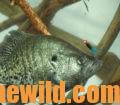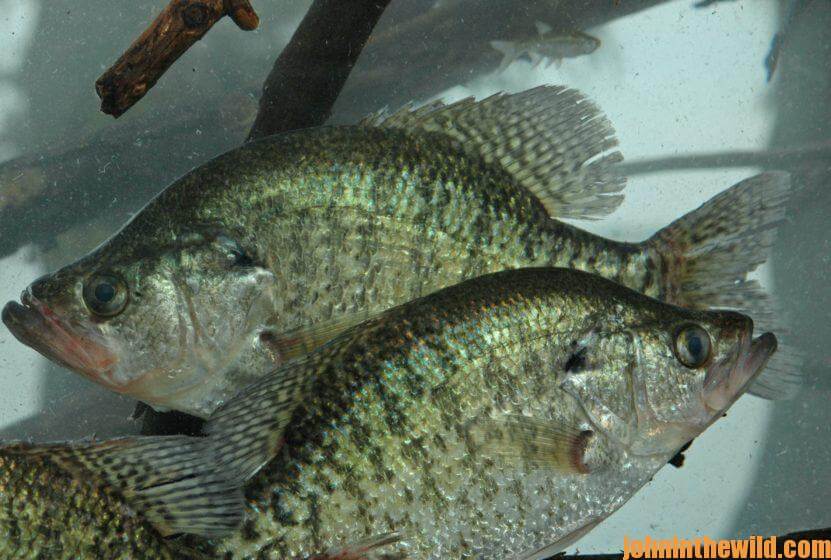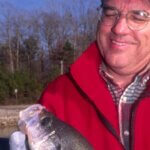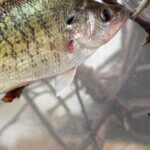Editor’s Note: During the end of March across much of the South, the weather and water will begin to heat-up. The crappie will move into the shallows near the bank to spawn. But, as often occurs at that time of year, one day when a friend of mine and I planned to fish for crappie, a late-winter cold front hit the lake. The crappie and the anglers who usually tried to catch them vanished, except for a few diehard fishermen who wouldn’t believe that spawning crappie would be affected by a severe weather change.
“Look at those people fishing down the bank,” my friend who crappie fished with no side-scanning or down-scanning depth finder, told me. “They can fish all day and night, but they’re not going to catch any good-sized crappie because the crappie aren’t on the bank after a cold front. However, we’re going to take plenty of crappie today. John, do what I tell you, and we’ll go home with a box full of papermouths.”
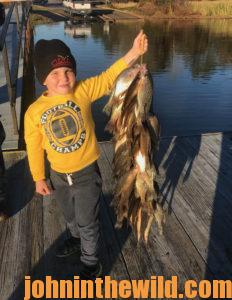 What he did next was one of the the strangest forms of crappie fishing I’ve ever tried. Using cane poles, minnows and corks, we fished 10-20 yards away from the bank in open water and not close to any type of visible cover or structure. Our corks sank continuously as big slabs came to the boat. I was amazed. From time to time, my bank-fishing instinct (that had produced crappie for me during the spring for more than 40 years) forced me to swing my minnows in closer to the bank and near treetops, submerged logs and stumps. Then my friend would say, “You may catch a little dumb crappie in there now and then, but if you want to take the most and biggest fish, stay out here in deep water.”
What he did next was one of the the strangest forms of crappie fishing I’ve ever tried. Using cane poles, minnows and corks, we fished 10-20 yards away from the bank in open water and not close to any type of visible cover or structure. Our corks sank continuously as big slabs came to the boat. I was amazed. From time to time, my bank-fishing instinct (that had produced crappie for me during the spring for more than 40 years) forced me to swing my minnows in closer to the bank and near treetops, submerged logs and stumps. Then my friend would say, “You may catch a little dumb crappie in there now and then, but if you want to take the most and biggest fish, stay out here in deep water.”
When I fished next to the shallow-water cover, I caught three-finger-sized crappie. But my buddy who was fishing in the open water at the front of the boat, consistently took more papermouths than me, and his fish averaged 3/4 – 1-1/2 pounds each. “I don’t understand why these fish are out here in open water during this cold front, even though it’s the spring of the year,” I told my friend. He answered, “What you must understand is that, yes, a cold front in the spring will move the crappie off the bank. But if you know where they go, you can be successful catching them. I’ve learned over the years that crappie don’t move far from where they’re planning to spawn. They just swim to deeper water and hold on cover that you can’t always see. There may be a small stump, some roots or some form of cover that you may not even be able to pick-up on your depth finder, 20-30 yards away, from where the fish are spawning. But, if you fish the proper water depth in the area where the fish want to spawn, you may catch the crappie – even when they’re not spawning.
“Many times I’ll use this same tactic, even if a cold front hasn’t moved on the lake during the spawn. Something that many crappie fishermen don’t understand is that not all crappie move into the bank to spawn at the same time. Nor does a crappie spawn out all of her eggs the first time she goes to the bank. Generally, a crappie will make two or three trips to the bank to spawn during the 3-4 weeks of the spawning season. Another factor to remember is that not all crappie spawn in shallow water. Therefore, there always should be some crappie close to the bank but not on the bank during the spawning season.” As I began to investigate how to find deep-water crappie, not only in the spring but at other times of the year, I learned that the most-consistent place to catch crappie at any time of the year is away from the bank.
The Most-Effective Crappie Attractors:
Most crappie fishermen who put out fish attractors place the brush or stake beds in either shallow water or deep water. However, there’s a strong case to be made for building brush shelters between the deep water and the shallow water of any reservoir or river, because crappie have a seasonal migration route they travel just like bass do. In the spring, crappie move-out of the deep river and creek channels into secondary creek channels and then to shallow water where they spawn. After they spawn, they return to the area between the creek channel and the banks before the temperature of the water drives them deep again. Serious crappie fishermen have learned that building brush shelters between the shallow water and the creek channel and fishing these features will produce more crappie during the spring and fall than fishing either the deep or the shallow water.
Crappie will hold in a staging area, which is usually between the creek channels that they’ve migrated up and into to reach the shallow water and the bank, before they eventually go to the bank to spawn. Crappie are searching for cover to hold in or around this staging area. If they find that cover, they’ll remain on the cover, until they go to the bank. Then they’ll hold on the cover until they’ve made enough trips between the cover and the bank to spawn out all their eggs. They’ll also stay in this region until the water heats up to the point that they have to return to the creek channels and eventually the river channels during hot weather.
In the fall of the year, when once again crappie move to shallow water, the crappie will inhabit these staging regions and move from the staging areas to the bank and away from the bank as the water cools down. As the water becomes colder, the crappie will spend more time on these fish attractors and less time in close to the shore, until the water is so cold that they must move back to the creek channels and even to the main river channels. So, to consistently catch more crappie during the fall and the spring, the angler should build or fish cover between the creek channel and the shallow-water spawning areas – no matter what the weather condition.
Some effective crappie attractors include:
* Crepe Myrtles – In the fall and winter, landowners will prune crepe myrtles. Crepe myrtles have long, spindly branches that grow almost straight-up. By putting these branches in 5-gallon buckets, and pouring concrete in those buckets, you’ll have inexpensive, portable fish attractors you easily can deploy in the water depths described earlier.
* River Cane – River cane is abundant on most waterways, grows straight-up, is easy to cut and lasts a long time. Put river cane in 5-gallon buckets filled with concrete to make portable reefs you can sink at varying water depths where you know crappie will be throughout the year.
* Cardboard Flats – Cans of beer and soft drinks are delivered in cardboard boxes, known as flats, which are about 4-6 inches high. By stringing rope, baling twine or cord in trees or attaching it to stakes 5-6 feet around and above the boxes, the cord will support the brush and hold it in place until the concrete hardens. Usually within 24 hours, you can place these flats in various water depths to at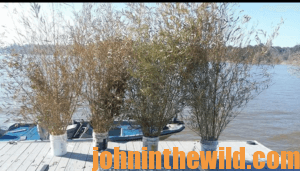 tract crappie.
tract crappie.
* Christmas Trees – One of the most-productive ways to use Christmas trees as fish attractors is to tie one end of a rope to a concrete block and the other to the base of the Christmas tree, leaving about 12-18 inches of rope from the block to the base of the tree. Cut a few of the branches out of the middles and tops of the trees to create crappie hideouts. When you drop the block into the water, the tree will stand up, and the branches will float above the block, especially with current. Put these trees on the edges of creek and river channels, so that even after they fall over and lay on the bottom, they still provide quality habitat for crappie moving from deep to shallow water.
* Stake Beds – Some crappie anglers will put out stake beds where crappie live by driving 4-6-feet long wooden stakes, usually 1x1s or 2x2s, 12-18 inches deep into the bottom of a lake. Then the stakes stick-up 3-4 feet off the bottom. Anglers use a 12-14 foot long manual-power stake drivers with small handles to drive the stakes into deep water. Other crappiers plant 4×4 or 4×6 wooden shipping pallets by placing a concrete block in each middle, nailing 40-50 stakes around the sides 6-8 inches apart and/or attaching them to the middles of the pallets.
To learn more about crappie fishing, check out John E. Phillips’ book, “Crappie: The Year-Round River Fisherman’s Bible” at https://amzn.to/2mxWIt4 available in 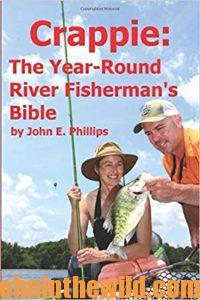 Kindle, print and for the Audible version at https://adbl.co/382m0SR.
Kindle, print and for the Audible version at https://adbl.co/382m0SR.
Tomorrow: How to Catch Crappie on Underwater Road Beds


